From early January to mid-February 1967.
- Umberto Tiboni locates a suitable place as the headquarters of the Mondo Beat Movement.
- The Court of Milan authorizes the publication of the magazine Mondo Beat and Melchiorre Gerbino officially takes over the direction of it.
- Vittorio Di Russo leaves the Movement.
On 1 January 1967 Melchiorre Gerbino telephoned Ezio Chiodini, the journalist he met in the Cinisello Balsamo morgue on the sad occasion of the death of Gennaro De Miranda. On that occasion Ezio Chiodini expressed his interest in following the events of the Mondo Beat Movement, therefore Melchiorre Gerbino would invite him to his apartment, where Vittorio Di Russo was hiding. Informed of Vittorio Di Russo's situation, Ezio Chiodini would in turn inform Italo Pietra, director of Il Giorno, the newspaper for which he worked.
On January 3, Melchiorre Gerbino went to the Chamber of Commerce, where he registered a company called Mondo Beat, intended for publications for schools. Then, in the company of Umberto Tiboni, he went to the Journalists' Association to register a student magazine called Mondo Beat. Luigi Marinatto, the councilor of the Journalist's Association who spoke with him, received a copy of the second issue of Mondo Beat magazine, to have a look at it, and arranged a telephone appointment with Melchiorre Gerbino, to inform him of the outcome of his application.
On January 4, thanks to the help of Fernanda Pivano, with whom Vittorio Di Russo maintained telephone contact, he was able to speak on the telephone with Alberto Dall'Ora, a well-known lawyer, who would go to the Police Headquarters to take vision of his file.
On January 5, Ezio Chiodini, in the company of Marco Mascardi, also a journalist from Il Giorno, went to Melchiorre Gerbino's apartment to interview Vittorio Di Russo.
On January 9, a full-page article appeared in Il Giorno, in which the life of Vittorio Di Russo was recounted and his current situation was described.
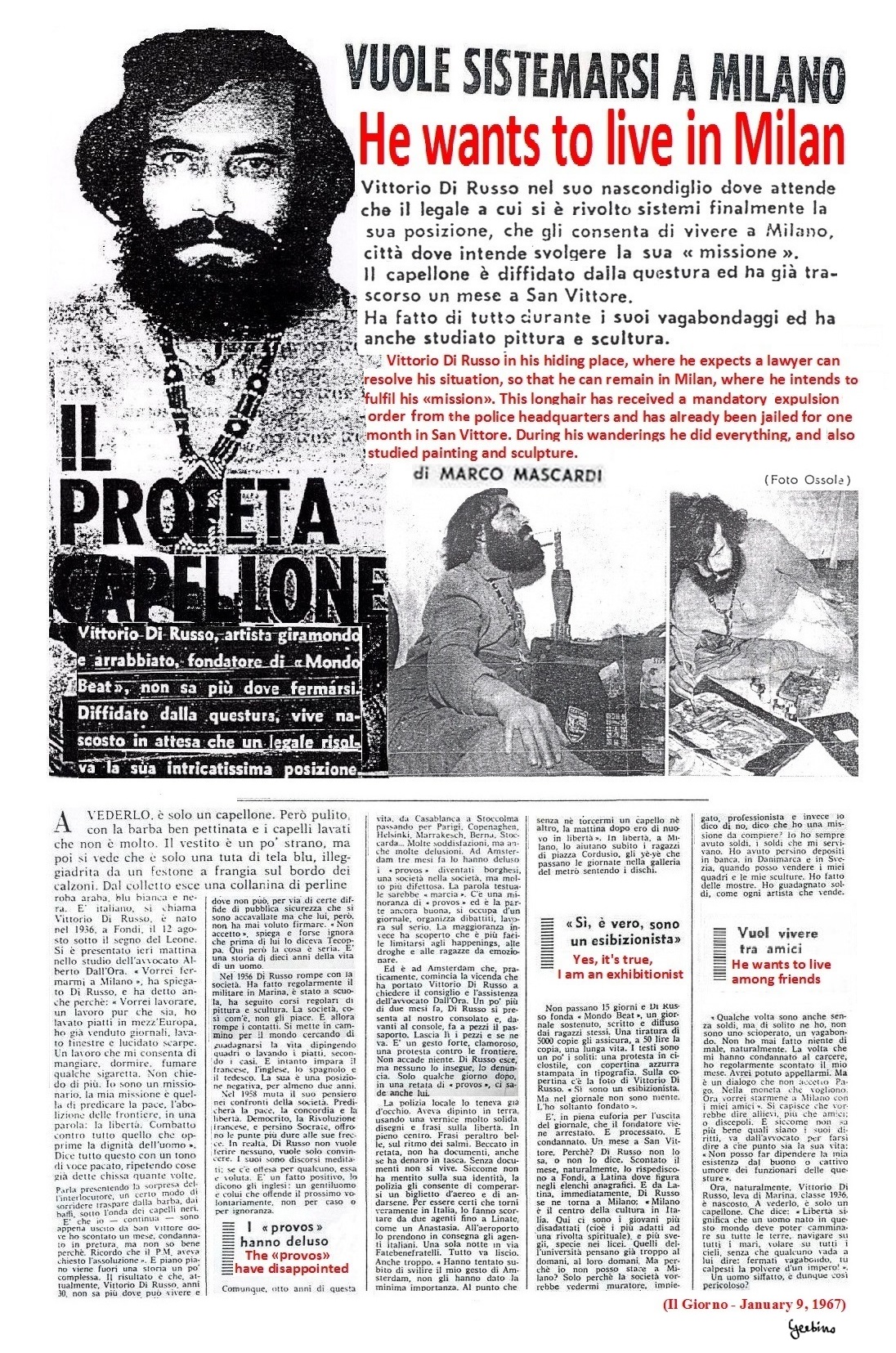
Vittorio Di Russo gave an interview while hiding in the apartment of Melchiorre Gerbino and Gunilla Unger.
On January 10, Melchiorre Gerbino went to the office of Alberto Dall'Ora, the lawyer who had been at the Police Headquarters to inspect Vittorio Di Russo's file. The lawyer told Melchiorre Gerbino that at the Police Headquarters they did not intend to revoke the expulsion order, but would have allowed Vittorio Di Russo to remain in Milan if he had refrained from taking action against the establishment, otherwise they would have taken him to court and having him sentenced to 3 months imprisonment. Consequently, the lawyer advised Vittorio Di Russo to leave Milan, so as not to live in a precarious condition.
Vittorio Di Russo, once informed by Melchiorre Gerbino, remained undecided on how to behave.
On January 11, Melchiorre Gerbino telephoned the councilor of the Journalist's Association, Luigi Marinatto, who informed him of the positive outcome of his application. As already described, Luigi Marinatto said he was pleased with the line of the magazine Mondo Beat and congratulated Antonio Pilati for his article "The castrated choices".
On 12 January Melchiorre Gerbino submitted documentation to the Court of Milan, requesting authorization to publish the fortnightly magazine "Mondo Beat", as owner and responsible director of the same, given that the two assignments could not be separated if a magazine was registered in the Special List of the Order of Journalists, as Mondo Beat was.
On the same day, Umberto Tiboni has found a place which seemed suitable as a seat for the Mondo Beat Movement. In his company, Gunilla Unger and Melchiorre Gerbino went to see it. The location was in the center of Milan, a 20-minute walk from Piazza Duomo. The venue, which was located on the ground floor, was equipped with two large metal shutters, behind which there were two glass windows, one fixed and the other serving as the entrance to a room of approximately 60 square meters. In one corner of the room there was a stone staircase leading to a large vaulted terracotta brick cellar. The entire facility was attractive and well maintained. The contractual conditions were the payment of Lire 175,000, corresponding to three months' advance rent; then, at the end of three months, the payment of Lire 175,000 again for the automatic renewal of the rent for another three months and so on.
On January 14, they rented those premises for a period of 3 months. Umberto Tiboni supplied Lire 75,000; Gunilla Unger and Melchiorre Gerbino together, Lire 100,000. They knew they would never recover this money. Umberto Tiboni, who had residence in Sesto San Giovanni, signed the lease agreement in his name, with the "commercial activity" as clause, so that the Police Headquarters could no longer expel him from Milan and, on the same day, he resigned from the company where he worked.
On January 15, they took possession of the premises, which Gunilla Unger and Melchiorre Gerbino have named "Cava", as the cellar resembled those caves the existentialists had attended in Paris and they themselves in Stockholm.
On the evening of January 16, Vittorio Di Russo was secretly taken to the Cave. Vittorio had suffered from paranoid crises while hiding in their apartment, but Melchiorre Gerbino and Gunilla Unger had managed to calm him down, thanks to the bond that had united them since the days of Stockholm. But once in the Cave, Vittorio had a paranoid crisis and suddenly became angry with Umberto Tiboni, who was shocked, because he had never seen Vittorio in those conditions.
On January 22, after three weeks in hiding, Vittorio Di Russo decided to leave Milan for Genoa, where he could move freely. Melchorre Gerbino accompanied him. Vittorio Di Russo was warmly welcomed by Barba, a well-known Beat in Genoa, who hosted him in a large room of his apartment, where Vittorio could paint and sculpt. But, leaving Genoa, Melchiorre Gerbino would have had the sad foreboding that Vittorio would soon leave Genoa for returning to Milan. Melchiorre Gerbino suffered a lot because of Vittorio Di Russo's situation, as it was stressful to be involved in it, and it was frustrating, since he couldn't do anything effective to help Vittorio.
On the evening of the same day, back from Genoa to Milan, Melchiorre Gerbino met with the guys from Onda Verde, who were happy because hundreds of copies of the magazine were sold in schools, where the students liked the merger of Mondo Beat and Onda Verde.
The last week of January passed quietly. Gunilla Unger and Melchiorre Gerbino met with Umberto Tiboni in the evenings and opened the Cave to welcome the most committed youths of the Mondo Beat Movement. They met in the Cave with great discretion, to prevent the police from noticing, as they hadn't yet received the license to publish Mondo Beat magazine, of which the Cave was registered as the official headquarters.
On February 2, 1967, Melchiorre Gerbino received authorization from the Court to publish Mondo Beat. He left the Alitalia company on the same day, as he did not need to anticipate resignation, since he was not yet a permanent employee. On the same day, Gunilla Unger informed lawyer Pisano that she would be leaving her job after 30 days.
On February 3 Melchiorre Gerbino and Umberto Tiboni opened the Cave to the public, after they had decided to keep the Cave open 24 hours a day and to allow anyone to enter for free and to linger at will.
It should be noted that, at the time, there were very few places in the world open 24 hours a day and accessible to anyone for an indefinite time, perhaps only the Cave of Mondo Beat and the New York subway, but to be able to stay on the New York subway indefinitely, you had to pay once for admission.
From the first hours of opening, there was the arrival to the Cave of Beats and Provos who lived in Milan. The following day, boys and girls arrived from the hinterland, then from everywhere. Youths who were in Florence from the time of the Flood begun to return to Milan and along with them arrived youths from other countries.
As he returned from Florence to Mondo Beat, Giorgio Contini would take on the task of managing the Cave's cellar, where a large cloakroom was created, where young people could leave their things without paying and for an unlimited time.
No one was required to produce identity documents to attend the Cave, but everyone had to strictly respect the 3 principles of Mondo Beat: no violence, no theft, no drugs.
The Italian boys who frequented the Cave had nicknames such as Ombra (Shadow), Grillo (Cricket), Zafferano (Saffron), Gesù (Jesus), Cristo (Christ), Giuda (Judah), Smilzo (Slender), Pasticca (Pill), Ercolino (Little Hercules), Roccia (Rock), Scheletrino (Thin Skeleton), some had American names like Ringo, Ronny... as for the girls, they tended to keep their birth name or nickname, some girls, who were typically Italian, wanted to be called Mamma, but there were also eccentric girls with names like Farfallina (Little Butterfly) and Sirena (Mermaid).
Some images of the Cave
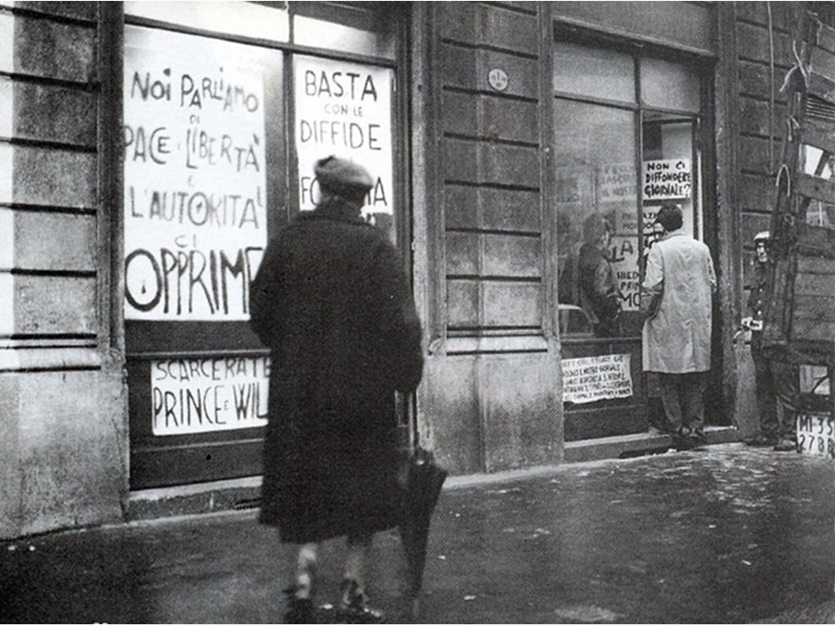
The exterior of the Cave.
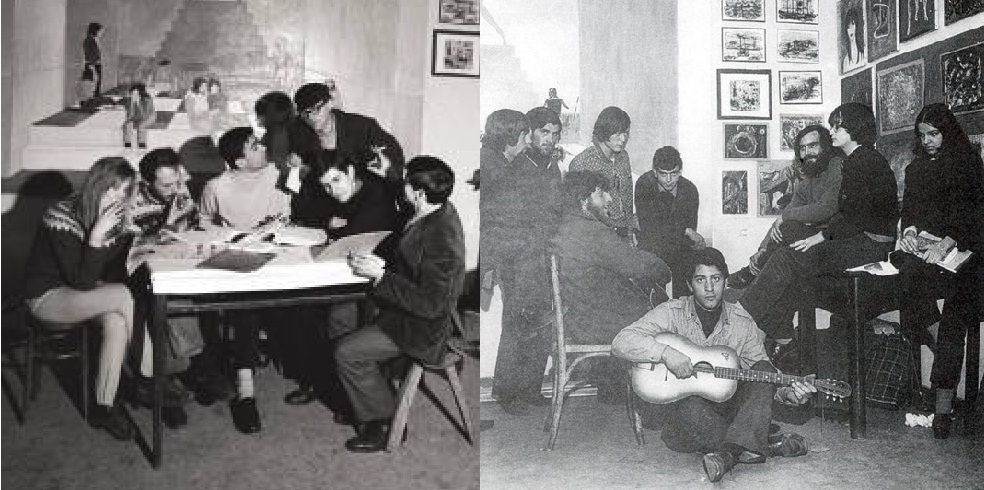
The groundfloor of the Cave.
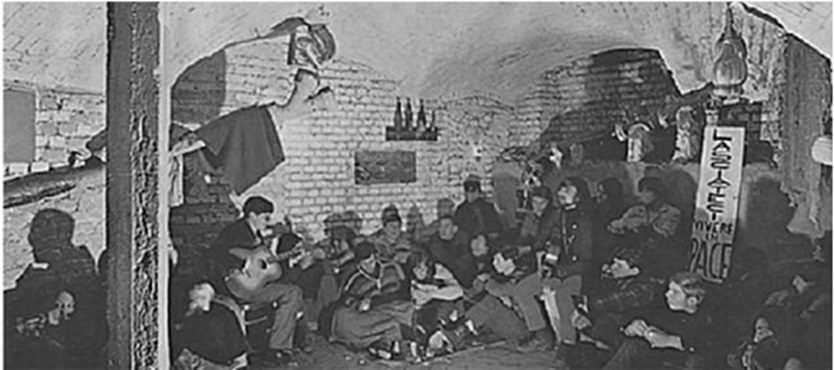
The cellar of the Cave.
Returning to the chronological reconstruction of the history of the Mondo Beat Movement, as Melchiorre Gerbino had foreseen, Vittorio Di Russo would have left Genoa to return to Milan. On February 5 he arrived at the Cave. He was in the company of Rosa, a Milanese girl who owned a flower shop. Vittorio remained in the Cave for a brief time, fearing that some police informant would report his presence.
From February 6, Vittorio and Rosa returned to the Cave every day. Then Rosa showed her concern for Vittorio's fate and asked Melchiorre Gerbino and Umberto Tiboni not have him there, and this was rather embarrassing for them, since they did nothing to put pressure on Vittorio Di Russo to stay in Cave.
As for Vittorio, while he feared that the police might arrest him, he was also nervous, because he realized that he had lost his influence on the young people of the Movement. It had remained inactive for too long, in a period in which exceptional events had occurred, such as the Handcuff Demonstration and the Flower Demonstration, and after these events to guide the Mondo Beat youths you had to direct them to further actions. But Vittorio could not act, because if he had done so the police would have arrested him immediately and a judge would have sentenced him to three months in prison.
On Sunday 12 February, Vittorio Di Russo arrived at the Cave, followed by six youths. It was around midday and the Cave was crowded with boys and girls. Vittorio went down the stairs, entered the cellar and shouted: "Enough! Let's get out of here! Let's go purify ourselves in Rapallo, in Barry McBuir's villa!".
Those who knew Vittorio were amazed, the others rimained indifferent. Melchiorre Gerbino said in a loud voice: "Go there, those of you who want to go to Rapallo! You can always come back here whenever you want."
And then Vittorio, with an imposing voice "Let's go!" - and went out of the Cave and the history of Mondo Beat.
The 6 youths who had followed him, including Barry McBuir, an Anglo-Italian whose mother had a villa in Rapallo, returned to the Cave half an hour after their departure.
In the days of Mondo Beat, Melchiorre Gerbino never met Vittorio Di Russo again. After the dissolution of the Mondo Beat Movement, Melchiorre Gerbino went to Vittorio Di Russo's house twice, to drink wine with him and strengthen their friendship, whose bonds would have resisted any adverse circumstance.
Melchiorre Gerbino left Milan in the autumn of 1967 and nine years later, passing through Milan while traveling around the world, he met Vittorio Di Russo again by chance. Vittorio said to him affectionately: "In Milan you left the memory of a great son of a bitch!"- and accompanied him to the Central station, to his train to Brussels.
Vittorio Di Russo and the youths of Mondo Beat on the ground floor of the Cave in February 1967 (1)
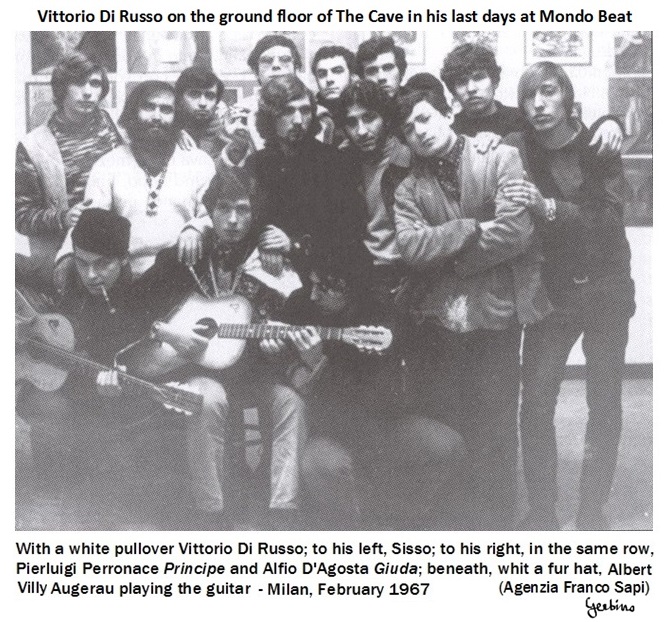
Vittorio Di Russo is in a white pullover, on his left, Sisso, on his right, in the same row, Pierluigi Perronace Principe and Alfio D'Agosta Giuda. Below, wearing a fur hat, Albert Villy Augerau plays the guitar.
Vittorio Di Russo and the youths of Mondo Beat on the ground floor of the Cave in February 1967 (2)
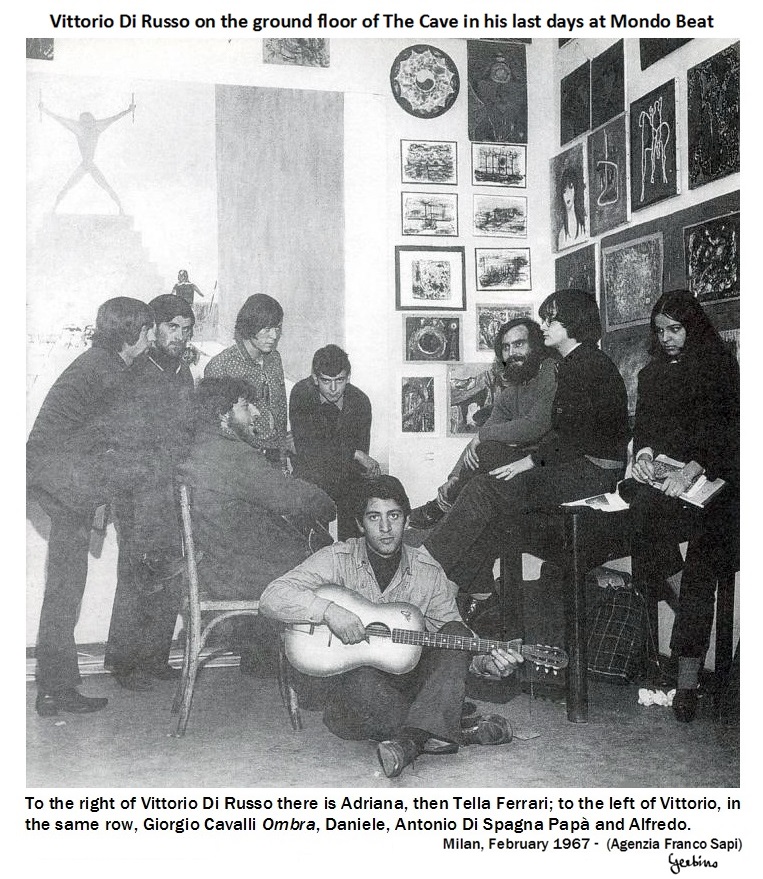
To the right of Vittorio Di Russo is Adriana, then Tella Ferrari. On his left, Giorgio Cavalli Ombra, Daniele, Antonio Di Spagna Papà (the one looking at the photographer) and Alfredo.
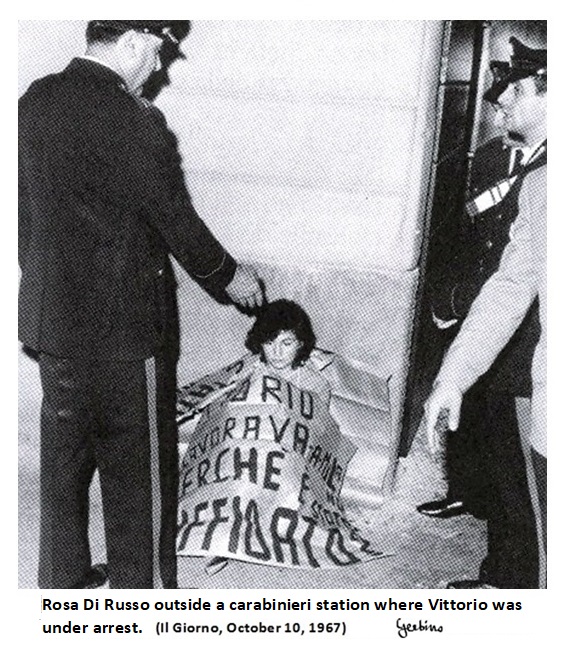
Rosa Di Russo outside a carabinieri station where Vittorio was under arrest.
Vittorio Di Russo's problems would not end immediately after the Mondo Beat days, because the police, fearing that he might act in Milan, had him under arrest from time to time, just to remind him that he could end up in prison for 3 months, if he made a false step.
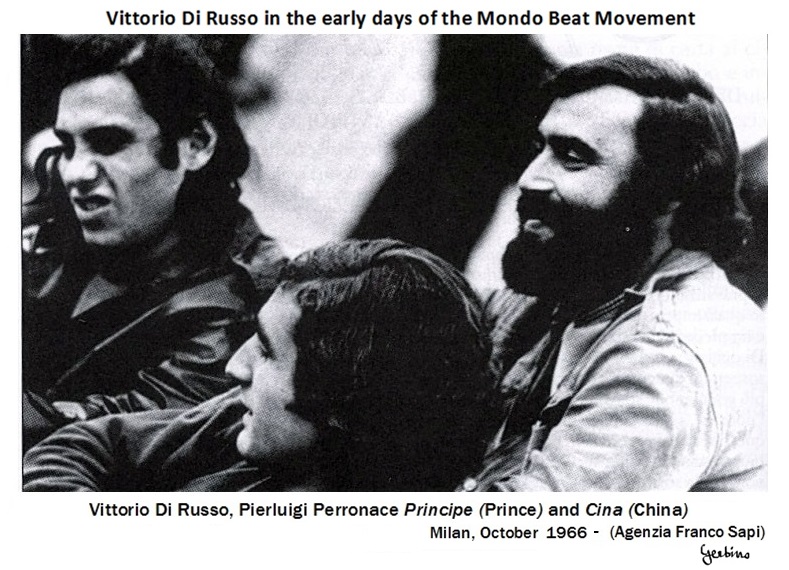
Vittorio Di Russo, Pierluigi Perronace Principe (Prince) and Cina (China) in the early days of the Mondo Beat Movement.
Vittorio Di Russo was the most charismatic character of the Mondo Beat Movement and the most generous. Three weeks of his activity were enough to start a historic movement. Those who knew him cannot forget his dreamy lion smile.







